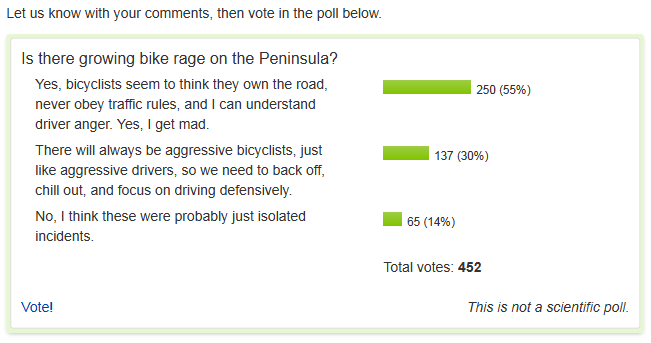
Many cyclists have asked themselves the question: Why do journalists fuel the anti-bicycle backlash? Hatred of cyclists has been proposed, as has the desire to maintain a car-centric society. There is no right answer. Each journalist has his or her own reasons for inciting hatred towards cyclists.
A flagrant example of a journalist’s desire to create friction between drivers and cyclists was published in the Burlingame Patch, which serves readers in California’s San Mateo County. In order to create hostility, the journalist gave the article an incendiary title: “Are Bicyclists Causing Justifiable Frustration for Motorists?”
Such a title creates the impression that cyclists have done something egregious to cause motorists to act out towards them. It further implies that cyclists deserve whatever motorists dish out, because they brought it on themselves.
Believe it or not, the article is about two men who were accused of intentionally trying to run down two teenage brothers who were riding their bicycles in San Mateo. The initial account of this incident occurred a few days earlier when the San Mateo Patch’s local editor reported about the DA’s Office charging the suspects in what she termed as an “alleged bicyclist attack.”
Notice the difference in the language these two journalists used.
One journalist, who reported about the criminal charges facing the driver and his passenger, referred to the actions of the motorists as an “attack on” two cyclists. The other journalist turned it around and suggested (without evidence) that the cyclists caused the attack they suffered at the hands of two motorists.
Here is what transpired:
“Witnesses reported two suspects in a gold pickup truck were harassing two male juveniles on bicycles, San Mateo Police Sgt. Dave Norris said.
According to prosecutors, Hernandez-Lopez drove up behind one of the brothers, ages 15 and 17, who were riding on their bikes and intentionally bumped the rear tire of the bicycle with his truck.
The victim didn’t fall, but instead turned onto the sidewalk area to escape and dropped his bicycle.
Hernandez-Lopez then allegedly drove onto the sidewalk and over the bicycle, which he dragged behind his pickup truck for several blocks, causing significant damage to the bicycle, prosecutors said.
While Hernandez-Lopez was driving over the bike, Burton, who was in the passenger seat, allegedly pulled out a fixed-blade knife and waved the knife at the brothers, according to prosecutors.
Witnesses took down the truck’s license plate number and police were able to apprehend the suspects shortly after.
Hernandez-Lopez has claimed the teenage brothers were swinging chains at them as they drove by, and that he never struck or dragged the bicycle. Burton denies the incident occurred.”
Both journalists agree with the facts as stated. One glaring difference is that the local editor who wrote the original article began the description of the events with “witnesses reported.” The second journalist, who was trying to make the cyclists look as if they had antagonized the motorists, started the description with “according to prosecutors.” He conveniently neglected to mention the presence of witnesses whose statements formed the basis for the prosecutors’ case against the suspects.
A highly critical reader called him out on his motives in the comment section.
“Andrew Boone 8:23 pm on Saturday, June 23, 2012
Dave Colby,
Patch readers are not as stupid as you must think they are.
Your completely ridiculous headline implies that hitting a bicyclist with a car, then driving on the sidewalk and running over a bicycle, is an incident of road rage that’s really the fault of bicyclists. Nowhere in the article is any illegal or even disrespectful behavior of the bicyclists described, except “swinging of chains”, which we have no way of knowing if the motorist made up or not.
Readers can tell the difference between objective, unbiased information and intentionally inflammatory and sensationalist information.
If Patch’s standards of what constitutes quality journalism continue to be this terrible, you can be sure that more and more readers will turn to The Almanac for their local news, which has far more high-quality articles than Menlo Park Patch.”
He was right to point out the subjective nature of this article. It was neither unbiased nor entirely factual. Yet, the newspaper ran the story anyway.
This should come as no surprise given the sort of things that make the news these days. However, what was unexpected was a reply from the Menlo Park Patch’s Editor. Her excuse for falsely accusing cyclists of causing their own attack was as follows:
“Vanessa Castañeda 10:23 pm on Saturday, June 23, 2012
Andrew, the paradox is that these types of headlines are the ones to which people respond most readily. Journalism in 2012 is more of a conversation than it was in 1965. The intent of this article was to generate discussion about a topic that clearly incites uneasiness in many people and explore the reasons why that occurs. Furthermore, ad hominem attacks are not productive. The real questions that we should be discussing are: Why do people label themselves as drivers or cyclists? What are the reasons that people who maneuver different machines to get from point A to point B can’t share the same routes in a civilized manner?”
Is she serious? Inflammatory headlines, with no consideration of ethics, are necessary because journalism in 2012 is more of a conversation than it was in 1965. Actually, she didn’t have to go back quite that far. Journalism wasn’t a conversation until the 2000’s when the Internet made news interactive.
The intent, in writing this article, was to “generate discussion about a topic that clearly incites uneasiness in many people.” Inflammatory titles don’t generate discussion. If you want people to talk about the problems between cyclists and motorists then you have to use an open-ended title — one which doesn’t place the blame on the victim.
In his quest to crucify the cyclists for being attacked and having their bike run over, the article’s author threw in a mention of the San Francisco cyclist, Chris Bucchere, who was recently charged for killing a pedestrian. His actions were supposedly “proof” that the two teenagers had done something wrong, even though none of the witnesses reported any such thing.
In the case of Bucchere, witnesses stated that he had been seen running red lights and stop signs before hitting the pedestrian. He was also trying to set a speed record when the incident occurred.
The journalist brought this unrelated story into the article to try to make it look as if the teenagers must have done something wrong, to precipitate the attack. Although it’s not uncommon to see motorists use this ploy, when journalists do it, under the pretense of reporting news, it can influence people who are not as discerning as the commenter who pointed out how low this publication’s journalistic standards were.
Other than the lame accusation about the boys swinging chains at the truck, there was nothing about the way they were riding their bicycles that could have justified an attack with a knife and running over and dragging a bicycle.
After manipulating readers into thinking that there was some justification for the attack, the author named this type of behavior “bike rage.” To find out whether his readers also felt mad at cyclists, he took a poll.

55% of the votes went to: “Yes, bicyclists seem to think they own the road, never obey traffic rules, and I can understand driver anger. Yes, I get mad.” Only 30% voted for: “There will always be aggressive bicyclists, just like aggressive drivers, so we need to back off, chill out, and focus on driving defensively.”
Cyclists deal with inflammatory journalism all the time. There is fallout for average cyclists who don’t cause problems on the road. They get harassed, and sometimes injured, for the wrongs perpetrated by a minority of cyclists, albeit the most visible ones. Yet people who work for the mainstream media see no harm in blatantly blaming innocent cyclists by using the argument that another cyclist did something wrong, therefore even seemingly innocent cyclists must have done something wrong, too — we just haven’t looked hard enough to find it.
On a lighter note, one of the commenters who agreed with how sensationalized this article was suggested that a journalist who justifies biased reporting by claiming to be giving readers what they want might be more successful as a drug dealer.
“Mary S.
8:44 am on Sunday, June 24, 2012
I agree, Andrew. This article, and Patch’s defense of it, are a joke.
Vanessa, your comment confirms that Patch is more interested in attracting eyeballs and $ than in professional reporting. Just because people respond to sensationalism doesn’t mean you need to feed it. If that is your attitude perhaps you might be more successful as a drug dealer, justifying your actions by claiming that you are simply giving people waht they want.”
Maybe Mary hit the nail on the head. Journalists, in 2012, are a lot like drug dealers. They justify unethical behavior, with the idea of catering to demand, in the name of profit. Profit comes first; ethics comes second. And consideration for the welfare of cyclists comes third.
Oh well, last again. Cyclists will have to spend more time in online comment sections, beating a dead horse, until motorists and journalists accept them as equals on the road.



